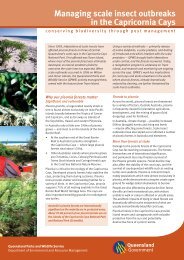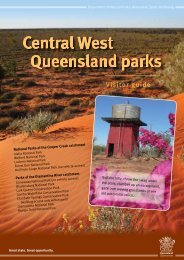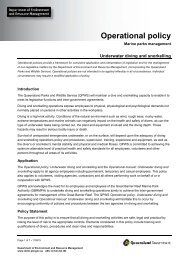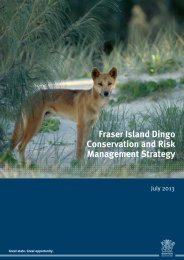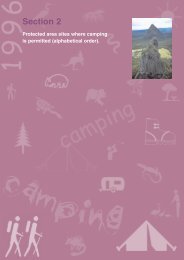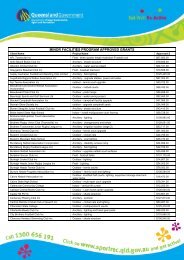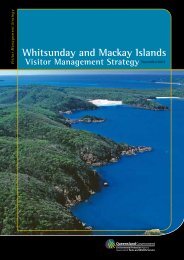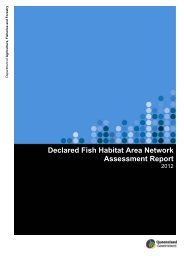Cooloola Recreation Area visitor guide - Department of National ...
Cooloola Recreation Area visitor guide - Department of National ...
Cooloola Recreation Area visitor guide - Department of National ...
Create successful ePaper yourself
Turn your PDF publications into a flip-book with our unique Google optimized e-Paper software.
Stay on the tracks<br />
Walk on designated tracks and avoid<br />
getting lost. Shortcuts damage plants<br />
and cause erosion.<br />
Be aware! Pets are not welcome everywhere. It is an <strong>of</strong>fence to take<br />
domestic animals into the <strong>Cooloola</strong> <strong>Recreation</strong> <strong>Area</strong> and national park.<br />
Penalties apply. See the centre map for the location <strong>of</strong> the dog-friendly<br />
beach area (southern Teewah Beach), where dogs are permitted on a<br />
leash and under control at all times.<br />
When driving into beach camping areas,<br />
use established or formed tracks. It is<br />
illegal to drive on dunes, unless on a<br />
formed track. Do not park vehicles or<br />
set up camp on vegetated dunes.<br />
Penalties apply.<br />
Toileting<br />
If camping without toilet facilities, it’s<br />
best to bring a portable toilet. A disposal<br />
facility is located opposite the Freshwater<br />
day-use area and on Clarkson Drive,<br />
Rainbow Beach. Otherwise, bury all<br />
faecal matter and toilet paper in a hole at<br />
least 50 cm deep and at least 100 m from<br />
watercourses, tracks and camp sites.<br />
Bag tampons, sanitary pads, disposable<br />
nappies and cigarette butts to bin later,<br />
as they all have parts that do not<br />
readily decompose.<br />
Keep food secure<br />
Let native animals find their own food.<br />
Animals that are fed can become<br />
aggressive to humans. They become<br />
reliant on the food source, suffer<br />
from disease or overpopulate to the<br />
extent that they dominate an area and<br />
aggressively exclude other wildlife.<br />
Fishing<br />
Fishing is popular in the Noosa River,<br />
along Teewah Beach and at Inskip<br />
Peninsula. On the beach, all refuse from<br />
fish cleaning, including <strong>of</strong>fal, scales and<br />
unused bait, should be buried at least<br />
30 cm deep below the high tide line.<br />
Refuse from fish cleaning must be<br />
removed from the river.<br />
The southern boundary <strong>of</strong> the Great Sandy<br />
Marine Park starts at Double Island Point.<br />
Zones regulate permitted fishing activities<br />
for future generations to enjoy.<br />
Save the area’s native fish. Do not dump<br />
aquarium fish or exotic water weed into waterways<br />
and lakes. Don’t let weed seeds and fungus hitch<br />
a ride into <strong>Cooloola</strong>. Come in clean.<br />
Photo: John Esdaile, Qld Govt.<br />
• Unauthorised taking <strong>of</strong> fish and<br />
other animals is strictly prohibited<br />
in <strong>Cooloola</strong>’s creeks and streams,<br />
including Searys Creek.<br />
• Fishing is permitted in the<br />
upper Noosa River and from<br />
<strong>Cooloola</strong>’s beaches.<br />
• Bag limits and size restrictions<br />
apply to some fish species.<br />
For more information visit Fisheries<br />
Queensland, <strong>Department</strong> <strong>of</strong> Agriculture,<br />
Fisheries and Forestry www.fisheries.qld.<br />
gov.au for rules and <strong>guide</strong>lines.<br />
Get to know your marine park<br />
Some waters surrounding northern<br />
<strong>Cooloola</strong> are protected within the<br />
Great Sandy Marine Park.<br />
Activities within the Great Sandy Marine<br />
Park are managed under a specific zoning<br />
plan to ensure safe and sustainable<br />
use <strong>of</strong> the marine park. Activities in<br />
the marine park may require a permit,<br />
but everyone is required to adhere to<br />
the regulations <strong>of</strong> the particular zone<br />
or designated area they are in. It is the<br />
<strong>visitor</strong>’s responsibilty to know what<br />
these regulations are before entering<br />
the marine park.<br />
Visit www.nprsr.qld.gov.au for<br />
more information.<br />
Fishing is fun,<br />
but remember marine<br />
park regulations may apply.<br />
Photo: Nieta Lee<br />
Keep waterways healthy<br />
Do not use soap, sunscreen, toothpaste<br />
or detergent in lakes and waterways.<br />
Doing so will promote the growth<br />
<strong>of</strong> algae and affect the purity <strong>of</strong> the<br />
water. Do any washing well away from<br />
waterways. Scatter washing water 100 m<br />
from waterways. Reduce the amount <strong>of</strong><br />
detergent by bringing non-greasy foods.<br />
Do not redirect streams or create<br />
small dams in shallow beach outflows<br />
or soaks, as harmful bacteria may<br />
accumulate and these areas attract<br />
cane toads.<br />
Use only defined canoe landing sites.<br />
Sedges and reeds on the riverbank are<br />
fragile. Tie canoes or kayaks rather than<br />
dragging them ashore. Use the jetties<br />
provided and observe no-landing zones.<br />
Photo: Adam Creed, Qld Govt.<br />
17



